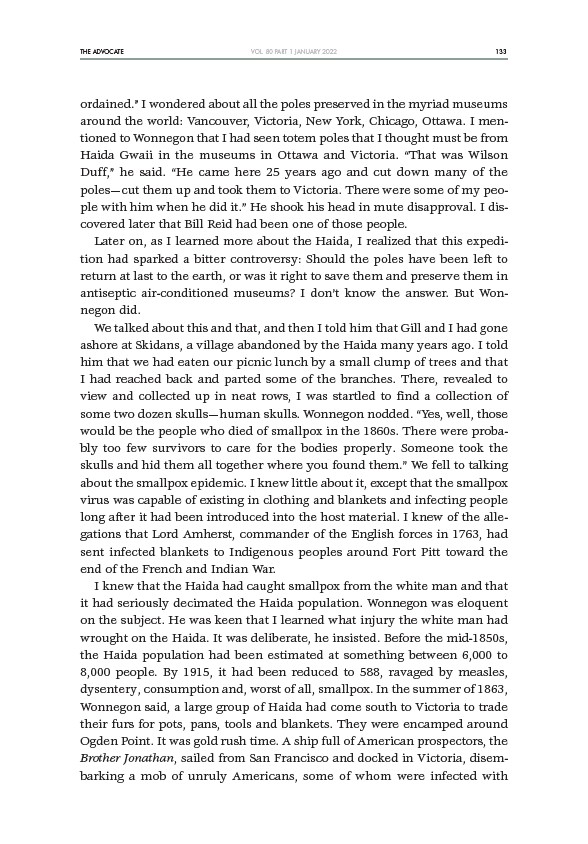
THE ADVOCATE 133
VOL. 80 PART 1 JANUARY 2022
ordained.” I wondered about all the poles preserved in the myriad museums
around the world: Vancouver, Victoria, New York, Chicago, Ottawa. I mentioned
to Wonnegon that I had seen totem poles that I thought must be from
Haida Gwaii in the museums in Ottawa and Victoria. “That was Wilson
Duff,” he said. “He came here 25 years ago and cut down many of the
poles—cut them up and took them to Victoria. There were some of my people
with him when he did it.” He shook his head in mute disapproval. I discovered
later that Bill Reid had been one of those people.
Later on, as I learned more about the Haida, I realized that this expedition
had sparked a bitter controversy: Should the poles have been left to
return at last to the earth, or was it right to save them and preserve them in
antiseptic air-conditioned museums? I don’t know the answer. But Wonnegon
did.
We talked about this and that, and then I told him that Gill and I had gone
ashore at Skidans, a village abandoned by the Haida many years ago. I told
him that we had eaten our picnic lunch by a small clump of trees and that
I had reached back and parted some of the branches. There, revealed to
view and collected up in neat rows, I was startled to find a collection of
some two dozen skulls—human skulls. Wonnegon nodded. “Yes, well, those
would be the people who died of smallpox in the 1860s. There were probably
too few survivors to care for the bodies properly. Someone took the
skulls and hid them all together where you found them.” We fell to talking
about the smallpox epidemic. I knew little about it, except that the smallpox
virus was capable of existing in clothing and blankets and infecting people
long after it had been introduced into the host material. I knew of the allegations
that Lord Amherst, commander of the English forces in 1763, had
sent infected blankets to Indigenous peoples around Fort Pitt toward the
end of the French and Indian War.
I knew that the Haida had caught smallpox from the white man and that
it had seriously decimated the Haida population. Wonnegon was eloquent
on the subject. He was keen that I learned what injury the white man had
wrought on the Haida. It was deliberate, he insisted. Before the mid-1850s,
the Haida population had been estimated at something between 6,000 to
8,000 people. By 1915, it had been reduced to 588, ravaged by measles,
dysentery, consumption and, worst of all, smallpox. In the summer of 1863,
Wonnegon said, a large group of Haida had come south to Victoria to trade
their furs for pots, pans, tools and blankets. They were encamped around
Ogden Point. It was gold rush time. A ship full of American prospectors, the
Brother Jonathan, sailed from San Francisco and docked in Victoria, disembarking
a mob of unruly Americans, some of whom were infected with